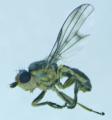Diptera.info :: Identification queries :: Diptera (adults)
Who is here? 1 guest(s)
|
Dutch name
|
|
| Robert Heemskerk |
Posted on 25-09-2015 17:22
|
|
Member Location: Amsterdam, Netherlands Posts: 2082 Joined: 17.10.05 |
ON several sites on the internet TAchina fera is called ''Woeste Sluipvlieg'' (dutch). And many people use this dutch name also for the species Tachina magnicornis. Is this correct? The use of this name brings two species to each other? Perhabs someone can clear this misunderstanding? Greetings Robert Heemskerk Greeting, Robert Heemskerk ---- WWW: http://robertheem...ndedag.htm --- |
| Zeegers |
Posted on 25-09-2015 18:43
|
|
Member Location: Soest, NL Posts: 18724 Joined: 21.07.04 |
'fera' = 'woest', so it is a literal translation of the scientific name. Which does not impress me Otherwise ... you are on your own (I cannot explain all stupid moves people make). I def. would not consider this as a scientific attempt to synonymize both species. and if so, they are wrong. Theo |
|
|
|
| Robert Heemskerk |
Posted on 25-09-2015 21:07
|
|
Member Location: Amsterdam, Netherlands Posts: 2082 Joined: 17.10.05 |
Thank you Theo, That is good to know. Sometimes it is good to search a bit further on the internet and to look what kind of source it got. Robert Greeting, Robert Heemskerk ---- WWW: http://robertheem...ndedag.htm --- |
| Paul Beuk |
Posted on 27-09-2015 17:51
|
|
Super Administrator Location: Netherlands Posts: 19311 Joined: 11.05.04 |
If you had mentioned 'Woeste sluipvlieg' to me I would have had to idea at all which species you were talking about, even though I am Dutch. In that case, what is the use of a vernacular name?
Paul - - - - Paul Beuk on https://diptera.info |
| John Carr |
Posted on 27-09-2015 20:48
|
|
Member Location: Massachusetts, USA Posts: 10084 Joined: 22.10.10 |
Very few insect species truly have common names. Most vernacular names for insect and bird species are proposed by specialists and never enter common use. More often a single name will apply to a genus or family. As I write this I see a chickadee outside my window. That is the name for a common American genus of small birds. Ornithologists suggest the name "black-capped chickadee" for the species found in New England, but everybody else says "chickadee" without qualification. Common names for species are mostly limited to pests. Non-specialists might say gallnipper (Psorophora ciliata), greenhead (Tabanus nigrovittatus), or boll weevil (Coleoptera: Anthonomus grandis). The first two are biting pests. The last is a notorious crop pest. Even in those groups, many other species share a common name. Most of the other hundreds of Culicidae go by the name "mosquito". Other Tabaninae are collectively called "horse flies". Other Curculionidae are called "weevils". Another American fly species with a name is Plecia nearctica, known in the South as the "lovebug". Mating pairs are very common at times. One paper says they are attracted to cars. |
| Paul Beuk |
Posted on 28-09-2015 13:47
|
|
Super Administrator Location: Netherlands Posts: 19311 Joined: 11.05.04 |
Well, here in the Netherlands in some groups all species have been given Ducth names for the sake of communication to the general public because they would be able to relate better to a species with a Dutch name than a species with a scientific name (only). In this way, as an example, three species of Brachiopa have been given Ducth names, the translations of which are: Pine sap hoverfly (Brachyopa testacea) Broad-leafsap hoverfly (Brachyopa scutellaris) Eastern sap hoverfly (Brachyopa pilosa) Firstly, these hoverfly rarely (if at all) enter communication with the general public. Secondly, the 'Eastern species' is found as far west as the Dutch coast (you cannot go much further west); where as the pine species has not been found west of the middle of the country; and the Eastern species is also found on deciduous trees. That ludicrousness combined with the totally breaking up communication with scientists and foreign specialists is for me the reason not to use Dutch names unless using one really makes sense. Another example, nearly all higher fungi have been given a Dutch name. Basically, whenever a species is found in our country for the first time, a Dutch name is attached to it. Next, probably the only time it is used is when it is reported new for the Dutch list in some formal publication and, if it is something 'spectacular', in the press release and the ensuing publications and programs. After that, no-one ever hears the name again (unless that first record is mentioned again). The Ducth name usually is so complicated that using its scientific name will be just as easy for anyone, specialist or not. Paul - - - - Paul Beuk on https://diptera.info |
| Jump to Forum: |
















